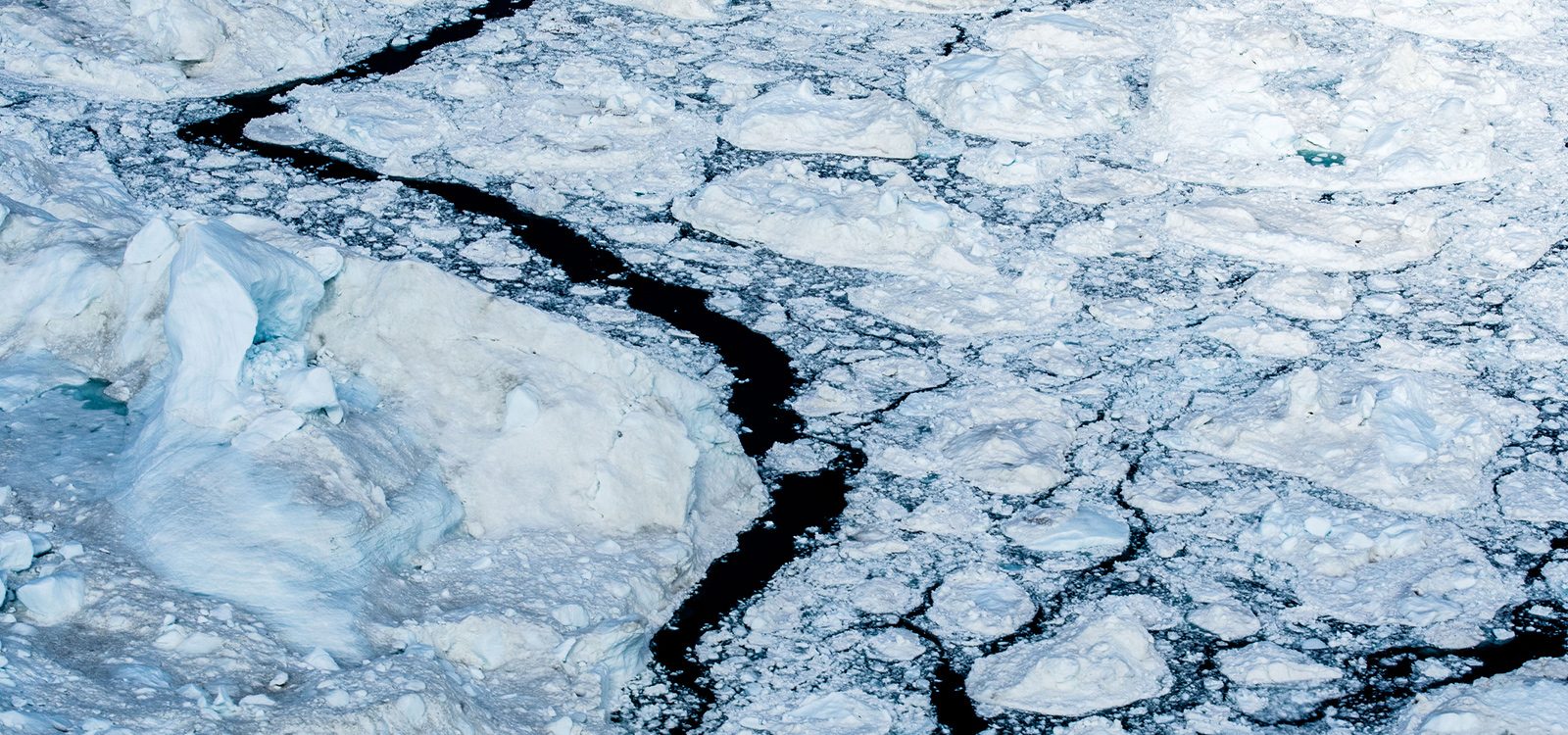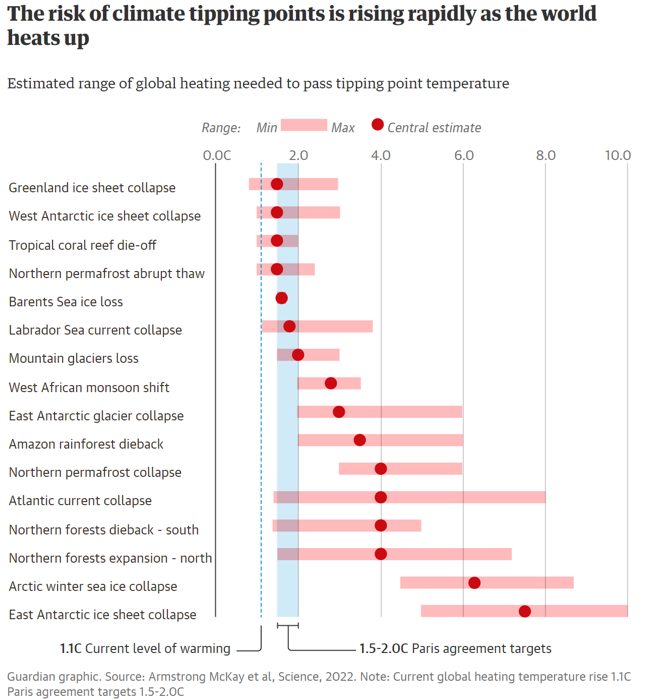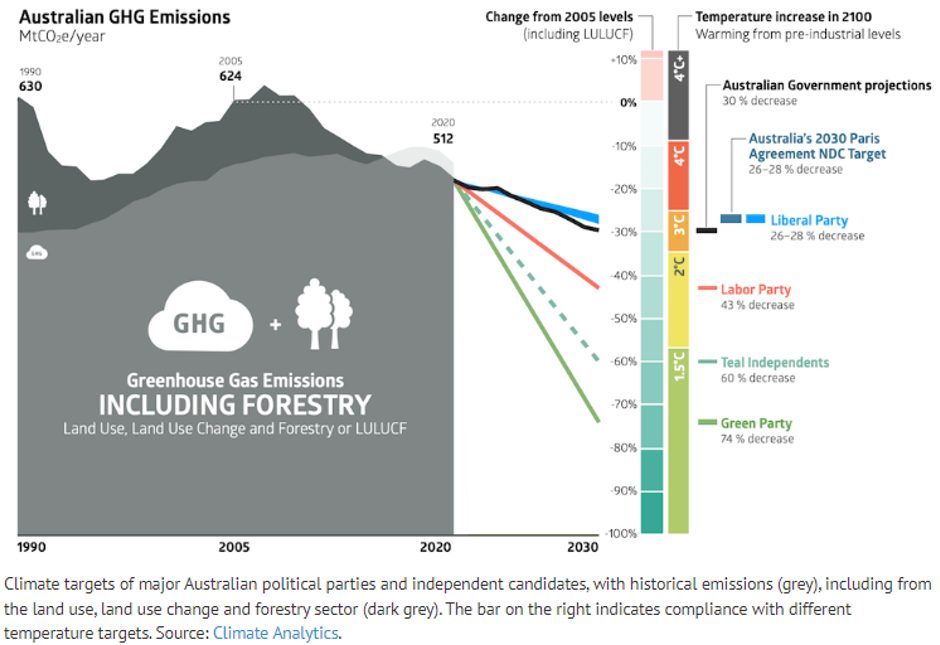
Climate tipping points
An area of mounting interest as the environmental impacts of climate change become increasingly obvious are ‘tipping points’.
In climate science, a tipping point is a critical threshold that, when crossed, leads to large and often irreversible changes in the climate system[1]. If tipping points are crossed, they are likely to have severe impacts on human society[2],[3]. Tipping behaviour is found across the climate system, in ecosystems, ice sheets, and the circulation of the ocean and atmosphere[3].
The below graphic from The Guardian shows a number of tipping points that are in danger of being reached or breached even if global temperature increases are kept within the goal limits in the Paris Agreement. The Paris Agreement has a long-term goal of holding the global average temperature increase to “well below 2°C above preindustrial levels and pursuing efforts to limit the temperature increase to 1.5°C above pre-industrial levels”.

The tipping points most at risk are discussed below (with further discussion in a report in Science[4]).
Greenland ice sheet collapse[5]
Scientists believe that the Greenland ice sheet will inevitably melt, even if fossil fuel burning ceased overnight. Global warming to date will lead to a sea level rise of 27cm from Greenland alone as 110 trillion tonnes of ice melts. Extrapolation to other ice caps would see a multi-metre sea level rise.
This 27cm measure is seen as a minimum as it accounts only for global warming to date and does not allow for future warming, and other drivers of ice loss are the margins of the ice sheet.
It is argued that this 27cm rise will inevitably happen over time as it arises from global warming that has already occurred.
West Antarctic ice sheet collapse[6]
The Thwaites Glacier in West Antarctica could singlehandedly raise sea levels significantly.
In March 2022 the Conger Ice Shelf in East Antarctica collapsed. Ice shelves act as plugs controlling ice flows from land to sea. The Thwaites Glacier acts similarly as a bottleneck protecting the West Antarctic ice sheet. If this ice sheet were to melt completely it would raise sea levels by around three metres.
In December 2021 the ice shelf in front of the Thwaites Glacier was showing enormous cracks indicating the ice shelf could disintegrate within a decade. This would leave the glacier unprotected. The Thwaites Glacier is an area the size of Florida and holds enough ice to raise sea levels around 60cms on its own.

Tropical coral reef die-off[7]
Coral bleaching: In healthy coral, its polyps are inhabited by algae (zooanthellae) which provide the coral’s colour and the nutrients and oxygen coral needs to survive. Under stress, e.g. from rising water temperatures, coral expels this algae which leaves the coral fragile and susceptible to disease and death.
As Australians are aware, coral bleaching is occurring in the Great Barrier Reef. Most recent research is suggesting that 90% of the reef is showing signs of bleaching. A recent survey of 911 areas in the Great Barrier Reef indicated only four showed no signs of bleaching.
Coral bleaching is also occurring in other coral reefs around the world. Reefs in the Cayman Islands have also suffered badly, among other sites around the world.
Coral reefs occupy about 0.2% of the seafloor but are home to 25% of marine species and 4,000 fish species. They provide shelter from predators, and storms and swells, as well as providing food or work for 500 million people worldwide. The Great Barrier Reef supports a $5 billion per annum industry.
Northern permafrost abrupt thaw[8]
Permafrost: A thick subsurface layer of soil that remains below freezing point throughout the year, and occurs chiefly in polar regions. As permafrost thaws, it releases methane and carbon dioxide into the atmosphere. This is because organic material frozen for thousands of years becomes available to microorganisms which convert it into greenhouse gases (GHGs). Methane is about 80 times more potent than CO2 over a 20-year period but doesn’t remain in the atmosphere as long.
Evidence shows that permafrost in the Arctic region is changing and degrading very rapidly. Modelling indicates this will lead to large increases in methane, although this isn’t yet showing up.
Thermokarst lakes are formed when permafrost thaws causing the ground to subside. These lakes are high GHG emitters, particularly of methane. These emissions are not currently included in modelling, so the modelling results are conservative.
Alaska has become a net GHG emitter through the effects permafrost thawing, rather than a storer of GHGs.
Concluding comment
The tipping points discussed above indicate the required urgency of global responses to climate warming. The Guardian Graphic above indicates that keeping global warming to a maximum of 1.5oC is marginally adequate at best and the target probably needs to be lower. The Climate Analytics graphic below indicates that the Australian Government’s 43% minimum reduction in GHG emissions by 2030 does not reach the 1.5oC threshold and more needs to be done.
This is clearly a field where actuaries have an important part to play in identifying and evaluating risk.

|
References
|
CPD: Actuaries Institute Members can claim two CPD points for every hour of reading articles on Actuaries Digital.






